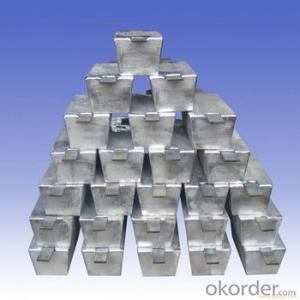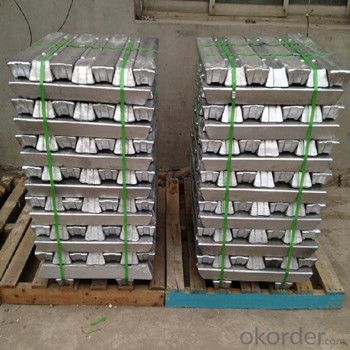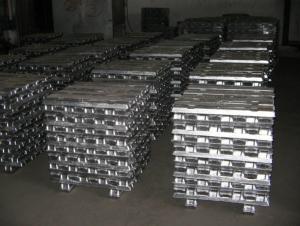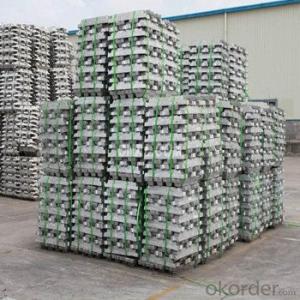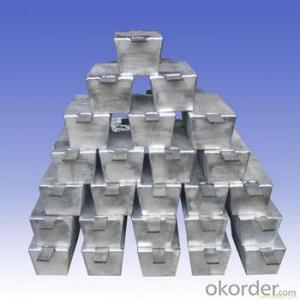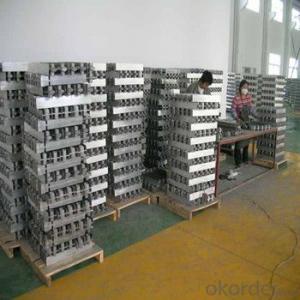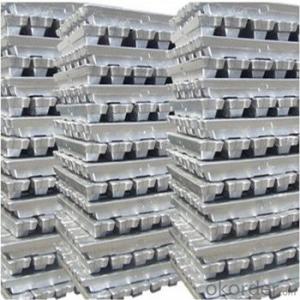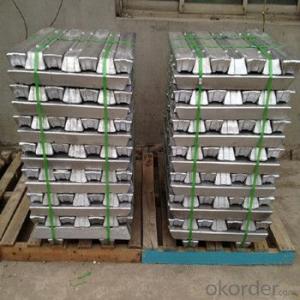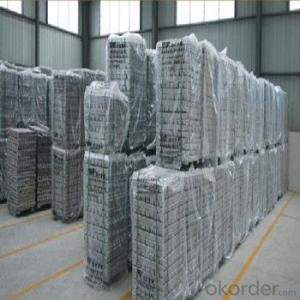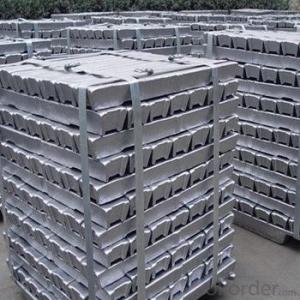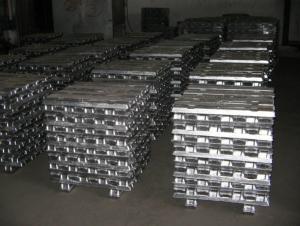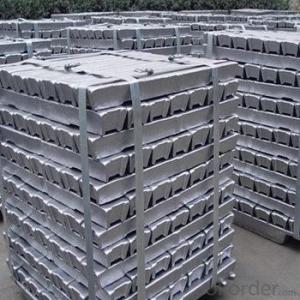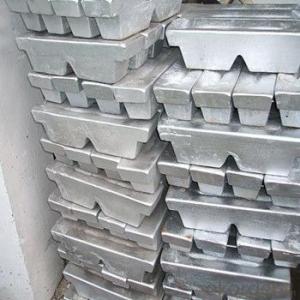Aluminium Ingot with High Purity Virgin from China
- Loading Port:
- China main port
- Payment Terms:
- TT OR LC
- Min Order Qty:
- 1000 m.t.
- Supply Capability:
- 10000 m.t./month
OKorder Service Pledge
OKorder Financial Service
You Might Also Like
Pure Aluminum Ingot Used for Industry
1.Structure of Aluminum Ingot Description
Aluminum Ingot is with the AL as the main chemical composition. Aluminum Ingot is used for industry,such as automobile,pinning and weaving,electron broadly and so on. Aluminum Ingot has the following advantages: easy control and operation, fast melting.
2.Main Features of the Aluminum Ingot
•High Purity
•Easy control and operation
•High strength
•Fast melting
•Competitive price
•Best Service
3. Aluminum Ingot Images


4. Aluminum Ingot Specification
Grade | Chemical Composition % | |||||||||
Al≥ | impurities ≤ | |||||||||
Si | Fe | Cu | Ga | Mg | Zn | Mn | others | Sum | ||
Al99.9 | 99.90 | 0.50 | 0.07 | 0.005 | 0.02 | 0.01 | 0.025 | - | 0.010 | 0.10 |
Al99.85 | 99.85 | 0.80 | 0.12 | 0.005 | 0.03 | 0.02 | 0.030 | - | 0.015 | 0.15 |
Al99.7 | 99.70 | 0.10 | 0.20 | 0.010 | 0.03 | 0.02 | 0.030 | - | 0.030 | 0.30 |
Al99.6 | 99.60 | 0.16 | 0.25 | 0.010 | 0.03 | 0.03 | 0.030 | - | 0.030 | 0.40 |
Al99.5 | 99.50 | 0.22 | 0.30 | 0.020 | 0.03 | 0.05 | 0.050 | - | 0.030 | 0.50 |
Al99.00 | 99.00 | 0.42 | 0.50 | 0.020 | 0.03 | 0.05 | 0.050 | - | 0.050 | 1.00 |
5.FAQ of Aluminum Ingot
We have organized several common questions for our clients,may help you sincerely:
①How about your company?A world class manufacturer & supplier of castings forging in carbon steel and alloy steel,is one of the large-scale professional investment casting production bases in China,consisting of both casting foundry forging and machining factory. Annually more than 8000 tons Precision casting and forging parts are exported to markets in Europe,America and Japan. OEM casting and forging service available according to customer’s requirements.
②How to guarantee the quality of the products?
We have established the international advanced quality management system,every link from raw material to final product we have strict quality test;We resolutely put an end to unqualified products flowing into the market. At the same time, we will provide necessary follow-up service assurance.
③How long can we receive the product after purchase?
In the purchase of product within three working days, We will arrange the factory delivery as soon as possible. The pecific time of receiving is related to the state and position of customers.Commonly 7 to 10 working days can be served.
- Q: What is an aluminum ingot?
- An aluminum ingot is a solid block or bar of pure aluminum metal that has been cast or molded into a specific shape. It is typically obtained through a process called smelting, where aluminum ore is heated at high temperatures to extract the metallic aluminum. Once the molten aluminum is obtained, it is poured into molds and allowed to cool and solidify, forming the ingot shape. Aluminum ingots are usually rectangular in shape, with flat, smooth surfaces. They are widely used in various industries, particularly in the production of aluminum products such as foil, sheets, rods, wires, and extrusions. The ingots serve as the raw material for further processing and can be melted down and reformed multiple times, making them highly valuable in the recycling industry. Aluminum ingots are known for their lightweight, corrosion-resistant, and high strength-to-weight ratio properties, which make them a preferred choice in various applications ranging from aerospace and automotive to construction and packaging.
- Q: What are the different grades of aluminum ingots?
- The different grades of aluminum ingots include primary, secondary, and specialty grades. Primary aluminum ingots are produced from pure aluminum ore and are of the highest quality. Secondary aluminum ingots are made from recycled aluminum and may contain impurities. Specialty grades of aluminum ingots are tailored for specific applications and can have unique properties, such as increased strength or corrosion resistance.
- Q: How are aluminum ingots used in the production of lighting fixtures?
- Aluminum ingots are used in the production of lighting fixtures as they serve as the primary material for constructing the fixtures' bodies and frames. The ingots are melted down and then cast into various shapes and sizes, allowing manufacturers to create durable and lightweight components for the fixtures. Additionally, the aluminum's excellent thermal conductivity helps dissipate heat efficiently, making it a suitable material for light fixtures that require effective heat management.
- Q: How are aluminum ingots stored and transported?
- To ensure the safety and quality of aluminum ingots, they are typically stored and transported in a meticulous and organized manner. Warehouses or storage facilities that are specifically designed for handling metals are commonly used for storing the ingots. These facilities are equipped with proper ventilation, temperature control, and moisture protection to prevent any damage or contamination. When it comes to storage, aluminum ingots are usually placed on pallets or in racks, depending on their size and weight. The arrangement of the ingots allows for easy access and ensures stability during storage. In certain cases, individual wrapping or protective materials may be used to prevent scratching or surface damage. For transportation, different methods are employed depending on the distance and quantity of the ingots. Forklifts or hand trucks are typically used for shorter distances and smaller quantities. It is important to securely fasten the ingots to prevent any movement or potential falling during transport. For longer distances and larger quantities, trucks, trains, or ships are commonly used. Specialized containers or trailers are used to securely hold the ingots and protect them from external factors. In some cases, shipping containers or flatbed trailers are used to transport the ingots. During transportation, it is crucial to handle and secure the aluminum ingots properly to minimize the risk of damage or accidents. The transportation containers or vehicles should have appropriate padding or cushioning to absorb any shocks or vibrations that could affect the ingots. Overall, the storage and transportation of aluminum ingots require careful planning, adherence to safety protocols, and the use of specialized equipment to maintain their quality and integrity throughout the process.
- Q: What is the melting point of aluminum ingots?
- Aluminum ingots typically reach a melting point of around 660 degrees Celsius, equivalent to 1220 degrees Fahrenheit.
- Q: Can aluminum ingots be anodized?
- Yes, aluminum ingots can be anodized. Anodizing is an electrochemical process that forms a protective oxide layer on the surface of aluminum. This process can be applied to aluminum ingots, sheets, or other forms. Anodizing provides several benefits such as increased corrosion resistance, improved durability, and the ability to add color to the surface. The anodized layer also enhances the aesthetic appearance of the aluminum and allows for better adhesion of paints or dyes. Overall, anodizing aluminum ingots is a common practice in various industries to enhance the properties and appearance of the metal.
- Q: How can the safety measures in aluminum ingot production be enhanced?
- There are multiple ways to enhance safety measures in aluminum ingot production: 1. Proper training programs should be implemented. It is crucial to provide comprehensive training to all employees involved in the production process. This training should cover the correct handling of equipment, awareness of potential hazards, and adherence to safety protocols. 2. Regular safety inspections should be conducted. Routine inspections of the production area can help identify potential safety hazards. This includes checking equipment for wear and tear, ensuring proper ventilation, and identifying potential fire or chemical hazards. 3. Access to and proper training in using personal protective equipment (PPE) is essential. All workers should have access to appropriate PPE, such as safety goggles, gloves, helmets, and protective clothing. This will help prevent accidents and exposure to hazardous materials. 4. A robust hazard communication program should be implemented. It is crucial to inform workers about potential risks associated with aluminum ingot production. This includes labeling hazardous materials, providing safety data sheets, and conducting regular safety meetings to keep workers informed about any updates or changes in safety procedures. 5. Emergency response plans should be developed and practiced. Having clearly defined evacuation routes, establishing communication protocols during emergencies, and training workers on how to respond to different types of emergencies, such as fires or chemical spills, are vital for mitigating risks. 6. Regular maintenance and equipment checks are necessary. Ensuring that all equipment used in the production process is regularly maintained and serviced can help prevent malfunctions and potential accidents. Regular checks and maintenance should include inspecting electrical systems, machinery, and other equipment for any signs of damage or wear. 7. Encouraging a culture of continuous improvement and monitoring is essential. It is important to identify and address any safety concerns. This can be achieved through regular safety audits, soliciting feedback from employees, and implementing necessary changes to improve safety measures. By implementing these measures, safety in aluminum ingot production can be significantly enhanced, minimizing the risk of accidents, injuries, and potential hazards.
- Q: What are the global production trends for aluminum ingots?
- The global production trends for aluminum ingots have been steadily increasing over the years. Aluminum is one of the most widely used metals in various industries, including aerospace, automotive, construction, and packaging. This demand has driven the growth of aluminum ingot production globally. The Asia-Pacific region, particularly China, has emerged as the largest producer of aluminum ingots. China's rapid industrialization and infrastructure development have significantly contributed to its dominance in aluminum production. The country's abundant bauxite reserves and low production costs have attracted numerous global manufacturers to establish their operations in China. North America and Europe also play a significant role in aluminum ingot production. These regions have a well-established manufacturing base and are home to several major aluminum producers. However, they face stiff competition from China due to its lower production costs. Furthermore, there has been a growing emphasis on sustainability and environmental consciousness in the aluminum industry. This has led to the adoption of energy-efficient technologies and the use of recycled aluminum scrap in the production process. Recycling aluminum reduces energy consumption and greenhouse gas emissions, making it a more sustainable option. As a result, the global production of recycled aluminum ingots has been steadily increasing, contributing to the overall production trends. In conclusion, the global production of aluminum ingots has been on an upward trajectory, with China leading the way as the largest producer. North America and Europe also contribute significantly to the production, although they face tough competition from China. The industry is also witnessing an increased focus on sustainability through the adoption of recycling practices.
- Q: What is the role of aluminum ingots in the production of aircraft?
- Aluminum ingots play a crucial role in the production of aircraft due to their unique properties and characteristics. These ingots, which are essentially blocks or bars of pure aluminum, serve as the primary raw material for manufacturing various components and structures in aircraft. One of the main reasons why aluminum ingots are preferred in aircraft production is their exceptional strength-to-weight ratio. Aluminum is a lightweight metal, making it ideal for aerospace applications where reducing weight is crucial for fuel efficiency and overall performance. By using aluminum ingots, manufacturers can produce lightweight parts that contribute to the overall weight reduction of an aircraft, resulting in improved fuel economy and increased payload capacity. Moreover, aluminum ingots possess excellent corrosion resistance, even in harsh environments. This property is particularly important for aircraft as they are exposed to various atmospheric conditions, including moisture, salt, and pollutants. The corrosion resistance of aluminum helps ensure the longevity and durability of aircraft components, reducing maintenance costs and enhancing safety. Furthermore, aluminum ingots are highly malleable and easily formable, allowing manufacturers to shape them into desired aircraft components through various manufacturing processes such as forging, extrusion, and machining. This versatility enables the production of complex and intricate parts, such as fuselage panels, wings, and landing gear, with precision and efficiency. In addition to their mechanical properties, aluminum ingots also exhibit excellent thermal conductivity. This characteristic is valuable in aircraft applications as it helps dissipate heat generated by engines, electronic systems, and other components. By efficiently transferring heat away from critical areas, aluminum contributes to the overall thermal management of an aircraft, enhancing performance and preventing overheating. Overall, aluminum ingots are essential in the production of aircraft due to their lightweight nature, corrosion resistance, malleability, and thermal conductivity. These properties enable the manufacturing of strong, durable, and efficient aircraft structures and components, contributing to the safety, performance, and reliability of modern aircraft.
- Q: What is the average price of an aluminum ingot?
- The price of an aluminum ingot can fluctuate based on several factors, including market conditions, supply and demand dynamics, and regional influences. As of [current date], the average price stands at around [average price]. Nevertheless, it is crucial to acknowledge that this value is prone to alterations. It is advisable to seek guidance from industry sources or market experts for the latest and most accurate pricing information.
Send your message to us
Aluminium Ingot with High Purity Virgin from China
- Loading Port:
- China main port
- Payment Terms:
- TT OR LC
- Min Order Qty:
- 1000 m.t.
- Supply Capability:
- 10000 m.t./month
OKorder Service Pledge
OKorder Financial Service
Similar products
Hot products
Hot Searches
